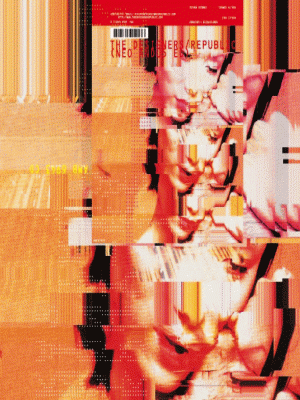The designers republic. Brain-Aided Design at La Capella
Exhibition by Ian Anderson and Xavier Calvo
Ever since the mid-Eighties, when a self-taught designer and post-punk musician from Sheffield named Ian Anderson began to design sleeves and inserts for records made by friends from his home town, the The Designers Republic have grown to become an essential reference in explaining the evolution of this discipline during the Nineties. Traditionally associated with independent record companies, especially avant-garde electronic music, the work of the The Designers Republic had been decisive not only in creating a visual aesthetic for the electronic scene, but also in the adaptation of graphic art to the CD format and in the application of digital tools introduced by Macintosh to design.
Even though their commercial output -which in recent years has expanded into TV ads, video clips, website design and graphic art for videogames- forms the basis of their work and is the side that first came to public attention, the DR has been involved in quite a different activity since the mid-Nineties. An entire body of art has been created for art galleries in the format of art objects that provide an outlet for other logistical and ideological interests. The "artistic" work of the DR, normally in the form of series of standards, falls into the field of cultural criticism, the main themes of which are consumerism, the totalitarian nature of the flow of images and messages in the media, and an analysis of the role of the artist in relation to the market system and the trend culture.
The idiosyncratic way in which the DR uses the gallery is based on its symbolic transformation into a space that is somewhere between a religious temple, a totalitarian commemorative pavilion and a shopping centre. There is a strongly ironic element in the colonisation of the gallery by their standards and images, as it takes the ambiguity inherent in the figure of the artist-vendor to its ultimate consequences, but fundamentally this type of action falls within the sphere of political culture. This activism, which shifts between satire and cultural guerrilla warfare, forms the theme running through this exhibition.
Brain-Aided Design at La Capella is probably the most representative and ambitious artistic action by the DRdue to the exhibition's size and the fact it covers a decade's work. It also reflects the DR's character as pop artists. The basis of their work consists of objects found in media culture -logos, elements from science fiction, manga and videogames- and their sampling of these elements is committed to a representation of media noise similar to that found in the cyberpunk movement. The DR's appropriation of the media and the codes of corporate culture are a neurotic rejoinder in the gallery to the consumer fever and the articulations of the conscious subjected to the white noise of the information media.
Xavier Calvo
Sponsors: Caja Madrid. Obra social
Sponsoring media: El País i Ràdio 4
Collaborate: Schilling




